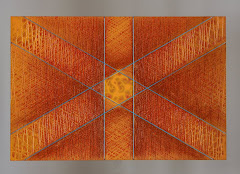You may be wondering what the hell interlocution is. For me it was one of those words I had a vague sense of, but when reading Charles Taylor and coming across his idea of "webs of interlocution" I realized I didn't actually know exactly what that meant. However, Dictionary.com came to the rescue (in fact, it had to rescue me at least a dozen times in the first 100 pages of his tome "Sources of the Self") and I discovered an interlocution is basically a conversation, a dialogue, sometimes an interrogation. In a way, you and I are in a web of interlocution right now as you read. So let me relate a small tale to draw you further into my web...
I was working installing an exhibition in downtown Denver, in a high-rise lobby adjacent to what is known as the 16th Street Mall. For ten or twelve blocks 16th Street is closed to automobile traffic, turning that stretch of downtown into a pedestrian shopping district. Its many restaurants and gift shops attract large crowds during warm weather and lunch time is especially busy as people pour out of the surrounding office buildings to imbibe and socialize. One day I was returning from my own gastronomic interlude when I was startled by the sight of a young man winding his way through the crowd dragging from his shoulder a massive wooden cross fashioned from 8"x8" lumber, much in the manner often depicted in illustrations from The Stations of the Cross in the New Testament (sans the crown of thorns of course; and if I remember correctly Jesus didn't have the benefit of a 2" thick foam pad protecting the shoulder of his modern day imitator - it seems martyrdom is getting softer these days). I stood watching in wonder at this fellow for a good 20 or 30 seconds, then proceeded on my way to the day's task at hand.
As odd as the scene was, something deeper struck me about the incident that I couldn't quite put my finger on, and the memory stayed with me through the remainder of the busy day. That evening at home I thought it through without distraction and realized what had been nagging me - namely, that no one in the crowded street paid much attention to the cross bearer other than to politely step out of his way. He was hardly acknowledged, much less impeded, or heckled, or laughed at, or even argued at. He was simply allowed to go about his business. I would imagine that a vast majority of the people in the crowd that day thought in their heart of hearts he was a fruitcake, a whack job, a nut case, or at best a deeply confused young man - I had certainly entertained all of the above opinions in my mind. But everyone, including me, left him alone.
Blame it on Charles Taylor, but I had morals on my mind and it occurred to me that all of those people had made a moral decision in relation to the unusual event, a decision to leave the young man alone and let him go about his business. I would suggest that decision was based on a modern western cultural moral sense that all individuals deserve respect and autonomy, even if they are a whack job, as long as they don't threaten others. Now this young man had every intention of intervening into the lives of the people out there that day by pointing out that they needed to be saved by Jesus, which might have raised the hackles of at least a few in the crowd. But there was another moral sense fairly unique to modern westerners at work here, the sense most of us have that the ordinary life, the life of family and work and citizenship, is quite good enough. And if the ordinary life is good enough, then we don't need to be saved!
But of course no one, including me, thought it through at all as the event unfolded. We just did it automatically - stepped out of his way and went on with our business. That suggests to me that there are something like deep structures, or as Taylor puts it frameworks, built into our consciousness that allow us to make these kinds of moral decisions all the time, even at lunch, without thought. In past times, or even now in other contemporary cultures, that man may have been chased by a mob, even stoned or flogged if he imposed himself in that flagrant manner. A culture like that would obviously have very different moral frameworks. How are these structures, these frameworks, built into us?
WEBS OF INTERLOCUTION! We're always talking, always arguing, always probing and challenging, even interrogating each other. And as I said dear reader, if you're still reading this you're in another web of interlocution (I've got you in my web, ha!) reading and agreeing or not agreeing, wondering what I mean and having a little dialogue with me in your head. The same is true of reading a book of philosophy or a novel, watching a film, or a TV show, listening to music. Webs of interlocution are everywhere! And they are building structures, moral frameworks, in our consciousness all of the time.
Which is why making art has a strong moral dimension. It is creating webs of interlocution, webs that are building moral structures, structures that fundamentally orient us to the good, however we define that in our time and place. And just perchance, building new and unforeseen frameworks, new moral senses, new definitions of the good.
Which bring me to another question - can we be in a web of interlocution with our bodies? Is that what Kundalini is, and if it is, who or what is talking to us? Hmmmm........
To be continued...
Tuesday, July 9, 2013
Subscribe to:
Posts (Atom)





.jpg)